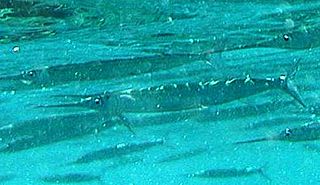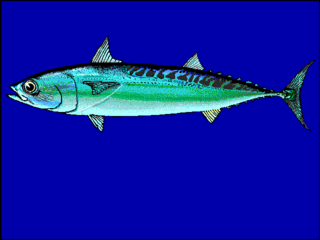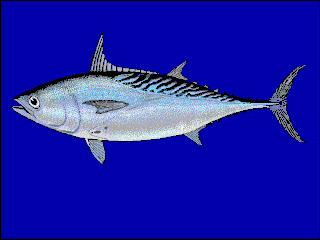
A tuna is a saltwater fish that belongs to the tribe Thunnini, a subgrouping of the Scombridae (mackerel) family. The Thunnini comprise 15 species across five genera, the sizes of which vary greatly, ranging from the bullet tuna up to the Atlantic bluefin tuna. The Atlantic bluefin averages 2 m (6.6 ft), and is believed to live up to 50 years.

Mackerel is a common name applied to a number of different species of pelagic fish, mostly from the family Scombridae. They are found in both temperate and tropical seas, mostly living along the coast or offshore in the oceanic environment.

The cutlassfishes are about 45 species of predatory fish in the family Trichiuridae found in seas throughout the world. Fish of this family are long, slender, and generally steely blue or silver in colour, giving rise to their name. They have reduced or absent pelvic and caudal fins, giving them an eel-like appearance, and large fang-like teeth.

The term billfish refers to a group of predatory fish characterised by prominent bills, or rostra, and by their large size; some are longer than 4 m (13 ft). Billfish include sailfish and marlin, which make up the family Istiophoridae, and swordfish, sole member of the family Xiphiidae. They are apex predators which feed on a wide variety of smaller fish, crustaceans, and cephalopods. These two families are sometimes classified as belonging to the order Istiophoriformes, a group with origins in the Late Cretaceous around 71 million years ago with the two families diverging from one and another in the Late Miocene around 15 million years ago. However, they are also classified as being closely related to the mackerels and tuna within the suborder Scombroidei of the order Perciformes. However, the 5th edition of the Fishes of the World does recognise the Istiophoriformes as a valid order, albeit including the Sphyraenidae, the barracudas.

Hemiramphus is a genus of schooling marine fish commonly called halfbeaks, garfish, or ballyhoos, and are members of the family Hemiramphidae. They inhabit the surface of warm temperate and tropical sea, and feed on algae, plankton, and smaller fish. Hemiramphus species are edible but are more important as food fish for larger predatory species including dolphinfish and billfish.

The butterfly kingfish is an ocean-dwelling ray-finned bony fish in the mackerel family, Scombridae – a family which it shares with the tunas, mackerels, Spanish mackerels, and bonitos. Unlike the 50 species from those four tribes, however, this species is unique in that it is the only scombrid to be classified apart from the rest, into the subfamily Gasterochismatinae and genus Gasterochisma.

Thunnus is a genus of ocean-dwelling, ray-finned bony fish from the mackerel family, Scombridae. More specifically, Thunnus is one of five genera which make up the tribe Thunnini – a tribe that is collectively known as the tunas. Also called the true tunas or real tunas, Thunnus consists of eight species of tuna, divided into two subgenera. The word Thunnus is the Middle Latin form of the Greek thýnnos – which is in turn derived from thynō. The first written use of the word was by Homer.

Batrachoides is a genus of toadfishes.

Sanopus is a genus of toadfishes restricted to the Atlantic coast of Central America and Mexico.

Zenarchopterus is a genus of viviparous halfbeaks. These fish are found in marine, brackish and fresh water of the Indo-Pacific region. Despite being in the viviparous halfbeak family, Zenarchopterus species are oviparous.

Auxis is a genus of ocean-dwelling ray-finned bony fish in the family Scombridae, and tribe Thunnini, also known as the tunas. Auxis, commonly and collectively called the frigate tunas, is one of five genera of tunas which comprise the Thunnini tribe.

Hyporhamphus is a genus of halfbeaks. The species in this genus are distributed throughout the warmer seas of the world, most species being Indo-Pacific and there are some freshwater species.

Euthynnus is a genus of ray-finned bony fish in the family Scombridae, or mackerel family, and in the tribe Thunnini, more commonly known as the tunas.

Colletteichthys is a genus of toadfishes found in the western Indian Ocean. The generic name is a compound of the surname Collette, in honour of the American ichthyologist Bruce Baden Collette to recognise his contribution to the study of toadfish, and the Greek ichthys meaning "fish".
Rhynchorhamphus is a genus of halfbeaks.
Belonion apodion is one of two freshwater needlefish in the genus Belonion, which is in the family Belonidae. It is native to South America where it is found in the basins of the Guaporè and Madeira Rivers. This species was described by Bruce Collette in 1966 with the type locality given as Laguna 3 kilometers southwest of Costa Marques on the Rio Guapore in Bolivia at border between Brazil and Bolivia. It is the type species of the genus Belonion.
Belonion dibranchodon is one of two needlefish, in the genus Belonion, which is in the family Belonidae in the order Beloniformes. They are native to South America within the Atabapo and Negro River basins, and can be found in freshwater environments within a benthopelagic range in a tropical climate. B. dibranchodon can reach about 4.8 cm (1.8 in) in length. This species is recorded to be oviparous; they produce their young by means of eggs. The eggs can be found on objects in the water attached by tendrils on the surface of the egg.
Rhynchorhamphus arabicus or Arabian flyingfish is a halfbeak of the family Hemiramphidae of the order Beloniformes.

Thunnus (Neothunnus) is a subgenus of ray-finned bony fishes in the Thunnini, or tuna, tribe. More specifically, Neothunnus is a subgenus of the genus Thunnus, also known as the "true tunas". Neothunnus is sometimes referred to as the yellowfin group, and comprises three species:

Thunnus (Thunnus) is a subgenus of ray-finned bony fishes in the Thunnini, or tuna, tribe. More specifically, Thunnus (Thunnus) is a subgenus of the genus Thunnus, also known as the "true tunas". Thunnus (Thunnus) is sometimes referred to as the bluefin group, and comprises five species:















